Digital Product Passport Implementation Based on Multi-Blockchain Approach with Decentralized Identifier Provider
Abstract
1. Introduction
- Smarter product use and manufacture: R0—Refuse: make a product redundant by abandoning its function or by offering the same product function with a radical different product, R1—Rethink: make a product’s use more intensive, R2—Reduce: increase efficiency in product manufacture, and R3—Reuse: the reuse by another consumer of a discarded product which is still in good condition;
- Life extension strategies: R4—Repair: the repair and maintenance of a defective product, R5—Refurbish: restore an old product and bring it up to date, R6—Remanufacture: use parts of a discarded product in a new product with the same function, and R7—Repurpose: use a discarded product or its parts in a new product with a different function;
- Creative material application: R8—Recycle: process material to obtain the same or lower quality and R9—Recover: the incineration of materials with energy recovery.
1.1. Motivation
1.2. Current Developments and Research in Digital Product Passports
1.3. Blockchain Technology Overview
2. Materials and Methods
2.1. Solution Architecture Overview
2.2. Interaction with DID-MB Blockchain
2.3. Digital Product Passport Data Model
2.4. Chaincode Implementation Details
3. Results
3.1. DPP Test Network
3.2. Performance Results
4. Discussion
5. Conclusions
Author Contributions
Funding
Institutional Review Board Statement
Informed Consent Statement
Data Availability Statement
Conflicts of Interest
References
- Circular Economy Action Plan—European Commission. Available online: https://environment.ec.europa.eu/strategy/circular-economy-action-plan_en (accessed on 15 May 2024).
- Circular Economy—Material Flows. Available online: https://ec.europa.eu/eurostat/statistics-explained/index.php?title=Circular_economy_-_material_flows (accessed on 15 May 2024).
- Erika, W.; Susanna, H.; Hannamaija, T.; Sonja, L.; Jaana, S.; Vesa, J.; Marjaana, K.; Patrycja, S.; Petrus, K.; Päivi, K.-R.; et al. R-Strategies in Circular Economy: Textile, Battery, and Agri-Food Value Chains; Natural Resources Institute Finland (Luke): Helsinki, Finland, 2023; Available online: https://jukuri.luke.fi/handle/10024/553461 (accessed on 15 May 2024).
- Mitra Apurba, M.H. Life Cycle Assessment Guide—KPMG Global. KPMG. Available online: https://kpmg.com/xx/en/home/insights/2023/10/life-cycle-assessment-guide.html (accessed on 15 May 2024).
- Digital Product Passport Powered by GS1 Standards. Available online: https://gs1.eu/wp-content/uploads/2024/05/GS1-in-Europe-DPP-Value-Proposition.pdf (accessed on 1 June 2024).
- Decentralized Identifiers (DIDs) v1.0. Available online: https://www.w3.org/TR/did-core/ (accessed on 15 May 2024).
- Dib, O.; Toumi, K. Decentralized Identity Systems: Architecture, Challenges, Solutions and Future Directions. Ann. Emerg. Technol. Comput. (AETiC) 2020, 4, 19–40. [Google Scholar] [CrossRef]
- Jansen, M.; Meisen, T.; Plociennik, C.; Berg, H.; Pomp, A.; Windholz, W. Stop Guessing in the Dark: Identified Requirements for Digital Product Passport Systems. Systems 2023, 11, 123. [Google Scholar] [CrossRef]
- Jansen, M.; Gerstenberger, B.; Bitter-Krahe, J.; Berg, H.; Sebestyén, J.; Schneider, J. Current Approaches to the Digital Product Passport for a Circular Economy—An Overview of Projects and Initiatives; Wuppertal Institut für Klima, Umwelt, Energie gGmbH: Wuppertal, Germany, 2022. [Google Scholar]
- Braud, A.; Fromentoux, G.; Radier, B.; Le Grand, O. The Road to European Digital Sovereignty with Gaia-X and IDSA. IEEE Netw. 2021, 35, 4–5. [Google Scholar] [CrossRef]
- Mügge, J.; Grosse Erdmann, J.; Riedelsheimer, T.; Manoury, M.M.; Smolka, S.O.; Wichmann, S.; Lindow, K. Empowering End-of-Life Vehicle Decision Making with Cross-Company Data Exchange and Data Sovereignty via Catena-X. Sustainability 2023, 15, 7187. [Google Scholar] [CrossRef]
- KEEP Innovation Project. Available online: https://keepelectronics.com/#/product/PF0H268N (accessed on 15 May 2024).
- Honic, M.; Magalhães, P.M.; Van den Bosch, P. From Data Templates to Material Passports and Digital Product Passports. In A Circular Built Environment in the Digital Age; De Wolf, C., Çetin, S., Bocken, N.M.P., Eds.; Springer International Publishing: Cham, Switzerland, 2024; pp. 79–94. [Google Scholar] [CrossRef]
- Alves, L.; Sá, M.; Cruz, E.F.; Alves, T.; Alves, M.; Oliveira, J.; Santos, M.; Rosado da Cruz, A.M. A Traceability Platform for Monitoring Environmental and Social Sustainability in the Textile and Clothing Value Chain: Towards a Digital Passport for Textiles and Clothing. Sustainability 2024, 16, 82. [Google Scholar] [CrossRef]
- Understanding the EU’s Digital Product Passport and How It Impacts Fashion Brands. Available online: https://www.carbonfact.com/blog/policy/eu-digital-product-passport (accessed on 31 May 2024).
- Ma, J.-Y.; Shi, L.; Kang, T.-W. The Effect of Digital Transformation on the Pharmaceutical Sustainable Supply Chain Performance: The Mediating Role of Information Sharing and Traceability Using Structural Equation Modeling. Sustainability 2023, 15, 649. [Google Scholar] [CrossRef]
- Zheng, Z.; Xie, S.; Dai, H.N.; Chen, X.; Wang, H. Blockchain challenges and opportunities: A survey. Int. J. Web Grid Serv. 2018, 14, 354–355. [Google Scholar] [CrossRef]
- Manski, S. Building the blockchain world: Technological commonwealth or just more of the same? Strateg. Chang. 2017, 26, 511–522. [Google Scholar] [CrossRef]
- Christidis, K.; Devetsikiotis, M. Blockchains and Smart Contracts for the Internet of Things. IEEE Access 2016, 4, 2292–2303. [Google Scholar] [CrossRef]
- Migliorini, S.; Gambini, M.; Combi, C.; La Rosa, M. The Rise of Enforceable Business Processes from the Hashes of Blockchain-Based Smart Contracts. In Enterprise, Business-Process and Information Systems Modeling; Lecture Notes in Business Information Processing; Springer: Cham, Switzerland, 2019; pp. 130–138. [Google Scholar] [CrossRef]
- Choi, T.-M.; Siqin, T. Blockchain in logistics and production from Blockchain 1.0 to Blockchain 5.0: An intra-inter-organizational framework. Transp. Res. Part E Logist. Transp. Rev. 2022, 160, 102653. Available online: https://ideas.repec.org//a/eee/transe/v160y2022ics1366554522000497.html (accessed on 16 May 2024). [CrossRef]
- Min, H. Blockchain technology for enhancing supply chain resilience. Bus. Horiz. 2019, 62, 35–45. [Google Scholar] [CrossRef]
- Saberi, S.; Kouhizadeh, M.; Sarkis, J.; Shen, L. Blockchain technology and its relationships to sustainable supply chain management. Int. J. Prod. Res. 2019, 57, 2117–2135. [Google Scholar] [CrossRef]
- Dutta, P.; Choi, T.-M.; Somani, S.; Butala, R. Blockchain technology in supply chain operations: Applications, challenges and research opportunities. Transp. Res. E Logist. Transp. Rev. 2020, 142, 102067. [Google Scholar] [CrossRef] [PubMed]
- Create DIDs and Identity Keys|Product Docs. Available online: https://docs.cheqd.io/identity/credential-service/dids (accessed on 30 May 2024).
- Hyperledger Fabric Docs—Introduction. Available online: https://hyperledger-fabric.readthedocs.io/en/latest/whatis.html (accessed on 22 February 2024).
- Hyperledger Fabric Docs—Using CouchDB. Available online: https://hyperledger-fabric.readthedocs.io/en/latest/couchdb_tutorial.html (accessed on 22 February 2024).
- Hyperledger Fabric Gateway SDK for Java. Available online: https://hyperledger.github.io/fabric-gateway-java/ (accessed on 22 February 2024).
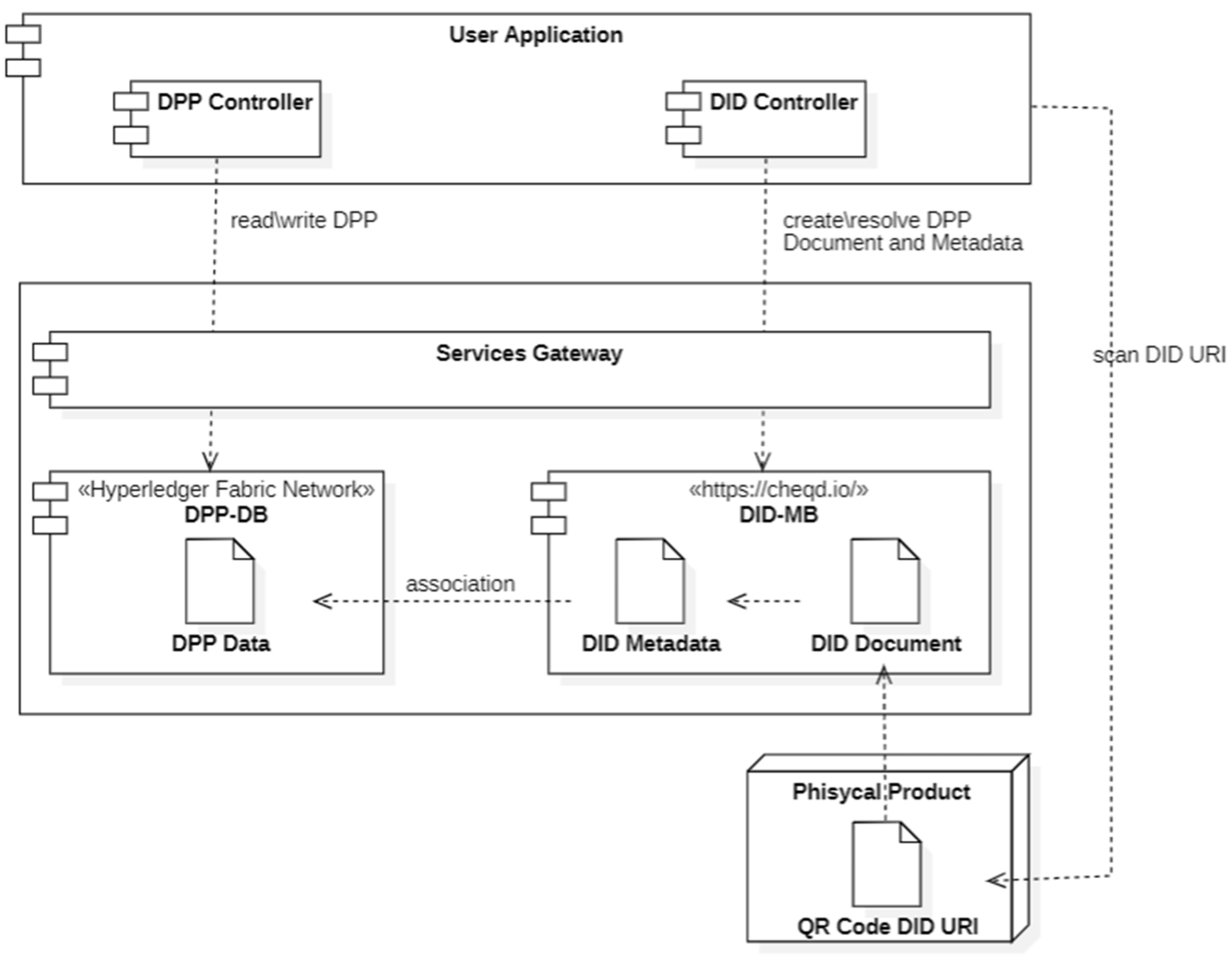

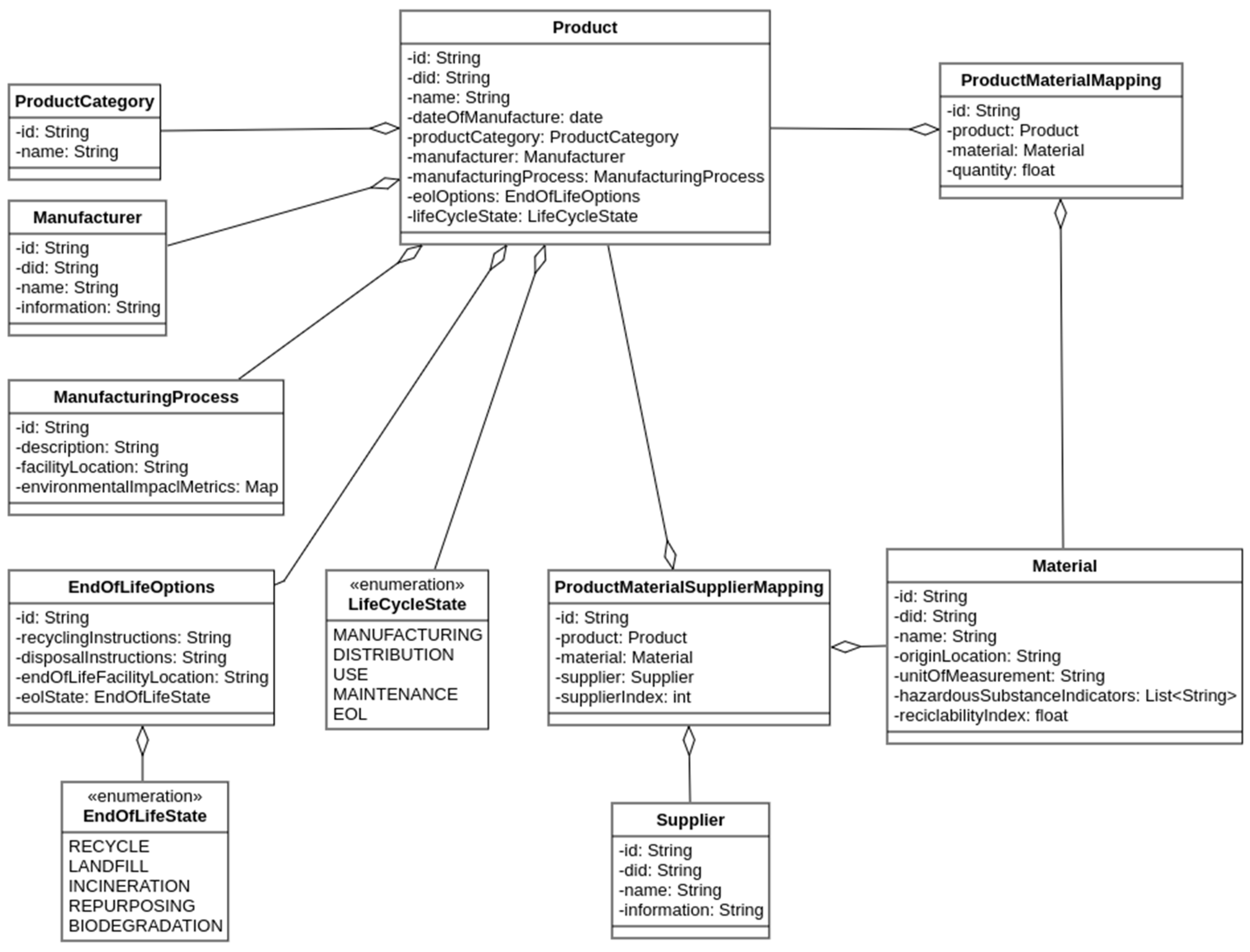
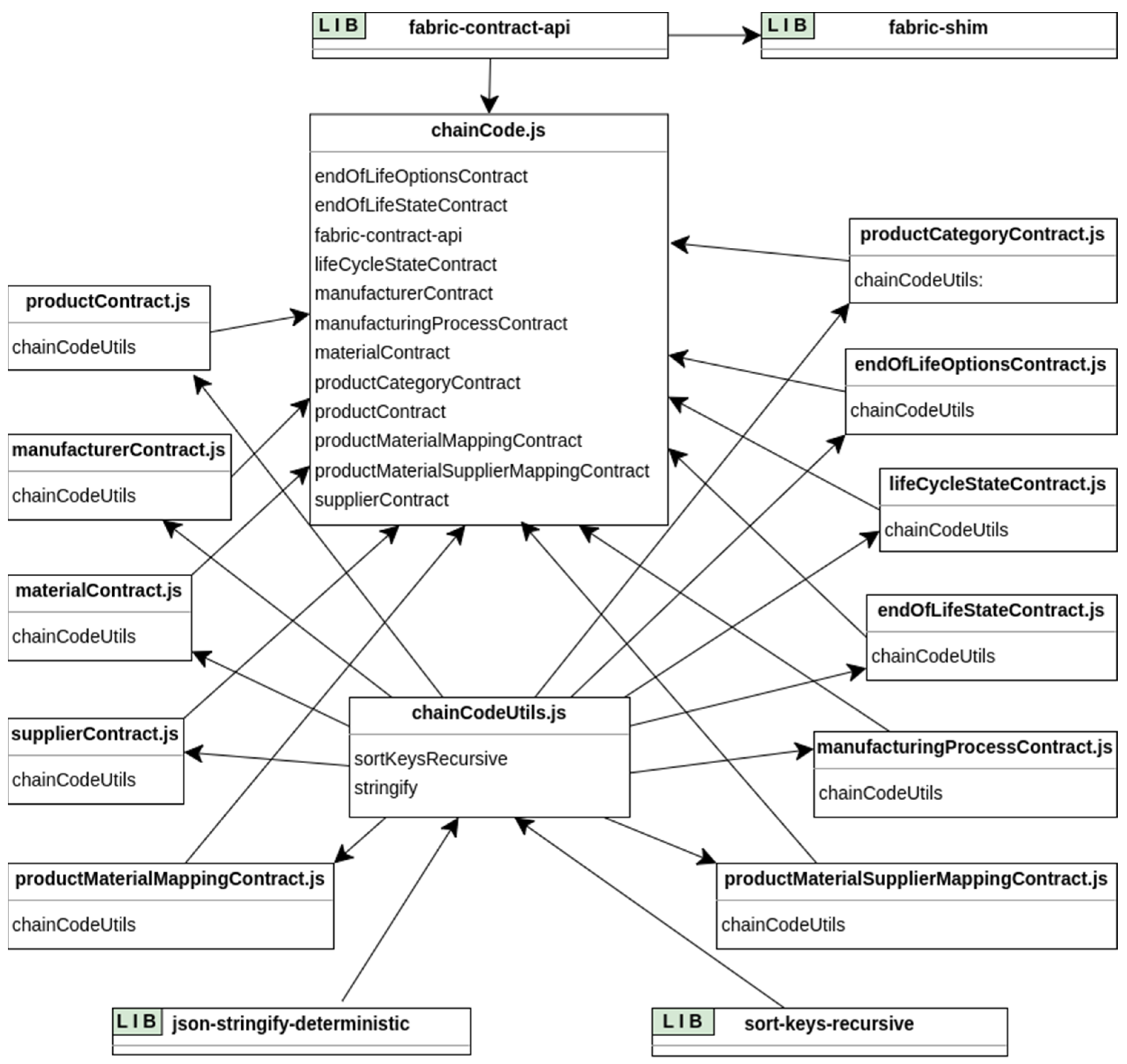
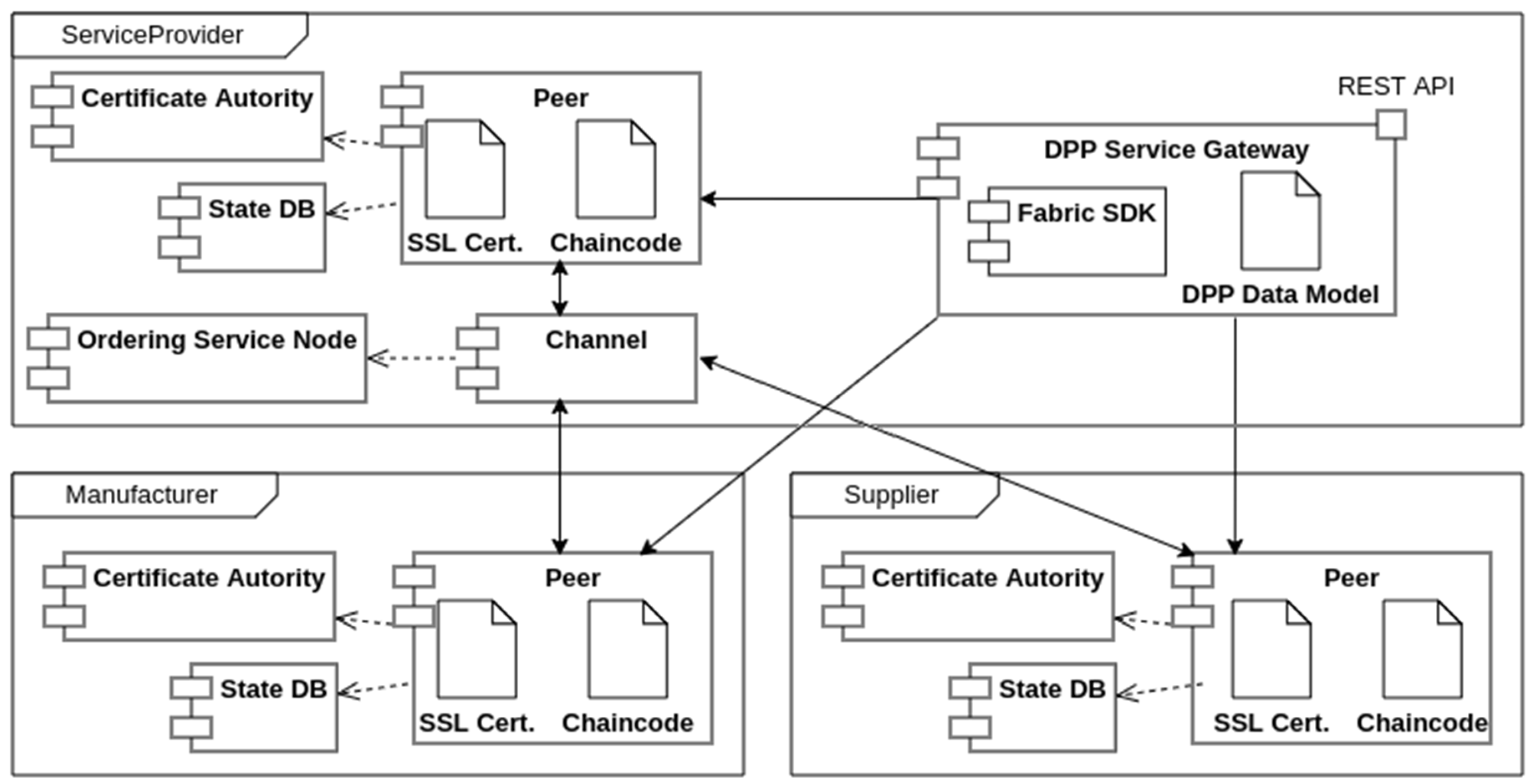
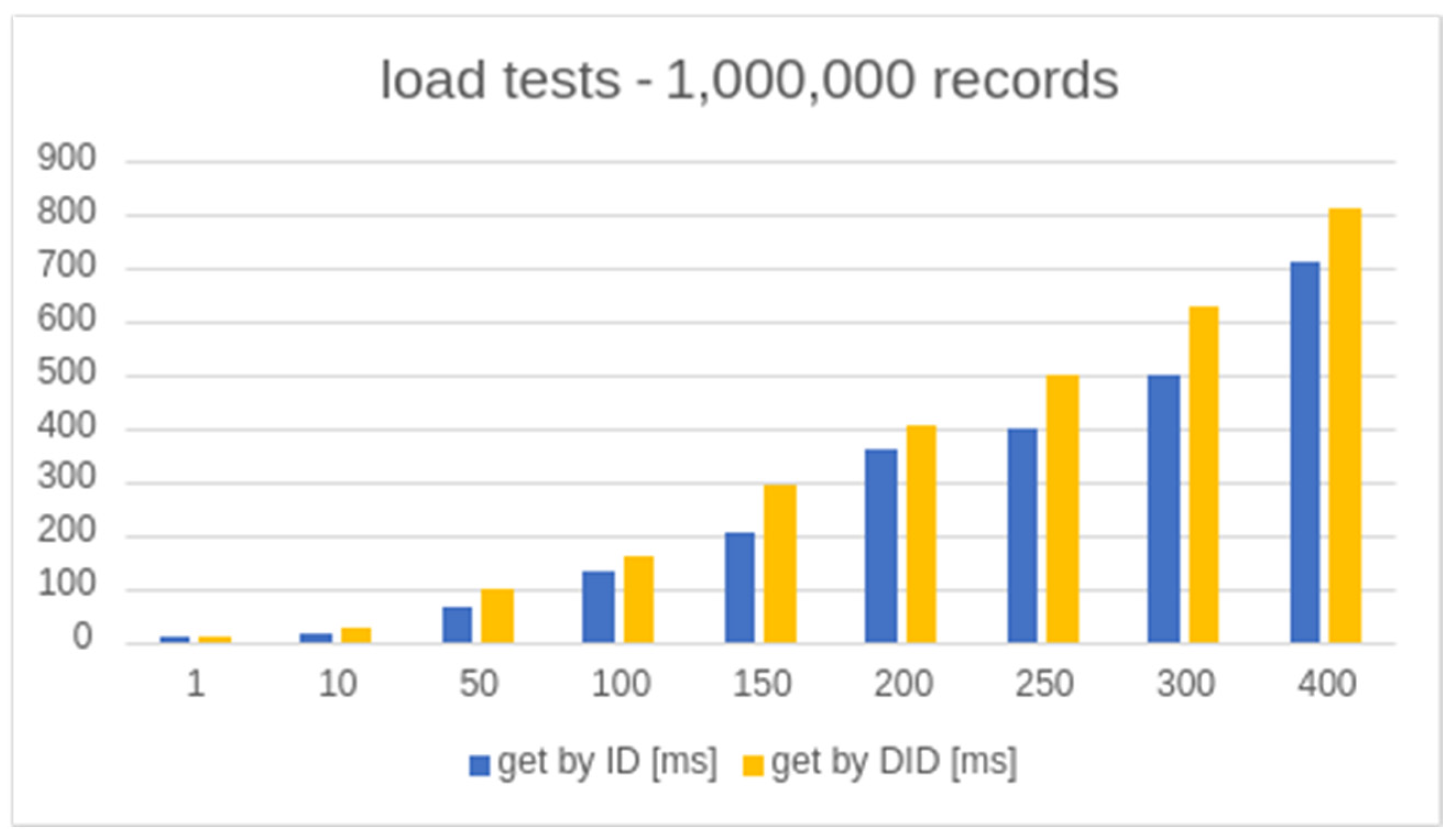
| Pre-existent Number of Records | Get Record by DID—No Index [ms] | Get Record by ID [ms] | Update Record [ms] | Delete Record [ms] |
|---|---|---|---|---|
| 1000 | 35 | 4 | 2052 | 2021 |
| 5000 | 138 | 4 | 2072 | 2152 |
| 10,000 | 298 | 4 | 2067 | 2073 |
| 50,000 | 1394 | 4 | 2082 | 2065 |
| 100,000 | 2752 | 4 | 2076 | 2084 |
| 1,000,000 | 26,325 | 4 | 2125 | 2091 |
Disclaimer/Publisher’s Note: The statements, opinions and data contained in all publications are solely those of the individual author(s) and contributor(s) and not of MDPI and/or the editor(s). MDPI and/or the editor(s) disclaim responsibility for any injury to people or property resulting from any ideas, methods, instructions or products referred to in the content. |
© 2024 by the authors. Licensee MDPI, Basel, Switzerland. This article is an open access article distributed under the terms and conditions of the Creative Commons Attribution (CC BY) license (https://creativecommons.org/licenses/by/4.0/).
Share and Cite
Hulea, M.; Miron, R.; Muresan, V. Digital Product Passport Implementation Based on Multi-Blockchain Approach with Decentralized Identifier Provider. Appl. Sci. 2024, 14, 4874. https://doi.org/10.3390/app14114874
Hulea M, Miron R, Muresan V. Digital Product Passport Implementation Based on Multi-Blockchain Approach with Decentralized Identifier Provider. Applied Sciences. 2024; 14(11):4874. https://doi.org/10.3390/app14114874
Chicago/Turabian StyleHulea, Mihai, Radu Miron, and Vlad Muresan. 2024. "Digital Product Passport Implementation Based on Multi-Blockchain Approach with Decentralized Identifier Provider" Applied Sciences 14, no. 11: 4874. https://doi.org/10.3390/app14114874
APA StyleHulea, M., Miron, R., & Muresan, V. (2024). Digital Product Passport Implementation Based on Multi-Blockchain Approach with Decentralized Identifier Provider. Applied Sciences, 14(11), 4874. https://doi.org/10.3390/app14114874









